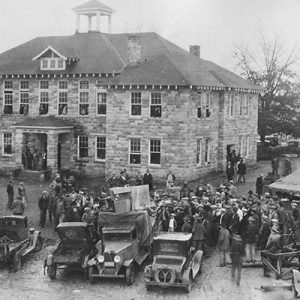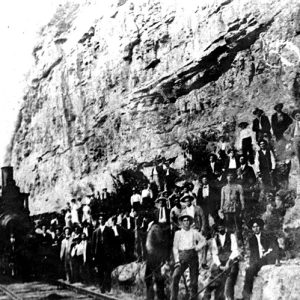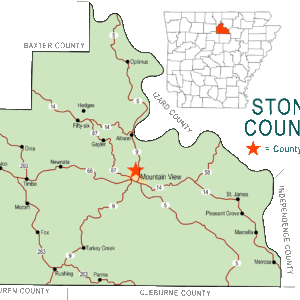calsfoundation@cals.org
St. James (Stone County)
St. James is a community on Highway 14 (East Main Street) between Batesville (Independence County) and Mountain View (Stone County). The White River is about two and a half miles west and can be reached by the Younger Access. Nearby Penters Bluff (Izard County) overlooks the river. St. James was first known as Shave Navel (a.k.a. Shaved Navel), though the origin of the name is unknown; it was later called Buck Horn (a.k.a. Buckhorn). How it received the name St. James is unclear, although a few residents have associated the name with the outlaw Jesse James. Buck Horn resident Walter Canard maintained that Jesse James had spent the night at his house when the outlaw was on his way to rob a stagecoach in Hot Springs (Garland County).
One of the first settlers of Buck Horn was Armistead Younger, who came from Halifax County, Virginia, via Tennessee with his family; they staked a land claim in the 1850s. The Younger family is still prominent in the St. James and Pleasant Grove (Stone County) communities. Family members claim to be relatives to the Younger Brothers of Missouri (part of the James Gang who traveled with Jesse and his brother Frank).
The first post office called Buck Horn opened in 1853 but was replaced by the Saint James Post Office in 1883; this closed in 1967, to be replaced by St. James Rural Station. Martha Ann Egnar Sutton served as the first postmaster. St. James Rural Station continued from 1967 until 1973. As there is no longer a post office at St. James, residents use the nearby Pleasant Grove post office.
From his hideout on a ridge above Walls Ferry, notorious bushwhacker Bill Williams and his gang terrorized Buck Horn and the surrounding area during the Civil War, robbing, looting, and pillaging until confronted by the Confederate troops of Brigadier General Joseph Shelby at Buck Horn on May 25, 1864. On that day, forty-seven of Williams’s men were killed, and the two captured were summarily hanged. It is claimed that more were killed in the Skirmish at Buck Horn than in any other single battle in the Batesville area during the war. A marker in present-day St. James commemorates the battle.
The infamous Connie Franklin murder case began in the spring of 1929 when Franklin was allegedly murdered near St. James and Red Stripe (now Pleasant Grove) by four men of the communities. Details remain sketchy. Franklin had recently arrived in St. James and started seeing a young woman of the community. Allegedly, the men waylaid the couple, sexually assaulted the woman, tortured and killed Franklin, and then burned his corpse. However, the case took a strange turn when, during the trial, a man claiming to be the murder victim, Connie Franklin, walked into the courtroom, resulting in a not-guilty verdict for the accused men. Many said it was an imposter, a trick by the defense; some alleged it was really Connie Franklin and the defendants had been framed. Still others told the media it was the ghost of Connie Franklin. Because of the adverse publicity, Red Stripe changed its name to Pleasant Grove. The apparent Connie Franklin died three years later of appendicitis.
Many in the St. James area worked on Works Progress Administration (WPA) projects and were part of Camp Hedges, Company 743, a Civilian Conservation Corps (CCC) camp in the Sylamore District of the Ozark National Forest.
Sam Younger, descended from early area settlers, was the featured fiddler in the house band at the Ozark Folk Center State Park in Mountain View for many years. Before that, he fiddled with Jimmy Driftwood in the early days of the Ozark Folk Festival in Mountain View in the 1960s. Steve Younger (a first cousin to Sam Younger) from St. James used to play with country music “outlaw entertainer” Billy Don Burns from Fifty-Six (Stone County) whenever Burns came to Mountain View; they called themselves the Younger Gang.
Farming and livestock are still the economic mainstays for the community. Many residents work in Mountain View or in Batesville. The Pinky Pruitt Barn, which was listed on the National Register of Historic Places on September 17, 1885, is located on Highway 14 in St. James; the single-crib plan barn was built around 1890.
In 1949, under Arkansas Act No. 1, a new district was formed called Stone County School District No. 1, which included all school districts in the county except for Mountain View. A county superintendent began overseeing the newly formed Rural Special (at Fox), Timbo, Fifty-Six, and Pleasant Grove school centers. The old school at Pleasant Grove, which still stands in the twenty-first century, also served the children of St. James until consolidation with the Mountain View School System around 1970. The school taught grades 1–12 and had a basketball team. The old Pleasant Grove school building then served as a church but was later renovated into a family dwelling.
For additional information:
Blevins, Brooks. Ghost of the Ozarks: Murder and Memory in the Upland South. Urbana: University of Illinois Press, 2012.
Gayler, Dorothy Greenway, and Davis Marie Younger. “Armistead Younger (1811–1883) Descendants in Stone County.” Unpublished manuscript, 1994. On file at Stone County Historical Society, Mountain View, Arkansas.
Mobley, Freeman K. Making Sense of the Civil War in Batesville–Jacksonport and Northeast Arkansas. Batesville, AR: Frank K. Mobley, 2005.
Phillips, Freda Cruse. Places of Our People: Stories of the People and Places of the White River Valley. Kearney, NE: Morris Publishing, 2011.
Kenneth Rorie
Van Buren, Arkansas
 Connie Franklin Trial
Connie Franklin Trial  Iron Mountain Railway Crew
Iron Mountain Railway Crew  Penters Bluff
Penters Bluff  Stone County Map
Stone County Map  Robert Younger Family
Robert Younger Family 




Thank you for mentioning Penter’s Bluff overlooking the Younger Access from Izard County. As I am a descendant of the John F. Penter family that arrived in Arkansas Territory in 1819 on that land close to Penter’s Bluff.